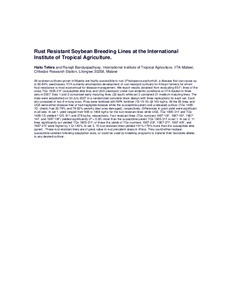| dc.description.abstract | All soybean cultivars grown in Nigeria are highly susceptible to rust (Phakopsora pachyrhizi), a disease that can cause up
to 60-80% seed losses. IITA currently emphasizes development of rust-resistant cultivars for African farmers for whom
host resistance is most economical for disease management. We report results obtained from evaluating 65 F7 lines of the
cross TGx 1805-31F (susceptible elite line) and UG5 (resistant) under rust-endemic conditions at IITA-Ibadan in three
sets in 2007. Sets 1 and 2 comprised early-maturing lines (22 each) while set 3 contained 21 medium-maturing lines. The
trials were established on 30 July 2007 in a randomized complete block design with three replications for each set. Each
plot consisted of two 6-m long rows. Plots were fertilized with NPK fertilizer (15-15-15) @ 100 kg/ha. All the 65 lines and
UG5 were either disease-free or had negligible disease while the susceptible parent and a released cultivar (TGx 1485-
1D, check) had 20-78% and 78-92% severity (leaf area damaged), respectively. Differences in grain yield were significant
in all sets. In set 1, yield ranged from 908 to 1468 kg/ha for the rust-resistant lines while UG5, TGx 1805-31F and TGx
1485-1D yielded 1125, 811 and 278 kg/ha, respectively. Four resistant lines (TGx numbers 1987-10F, 1987-15F, 1987-
14F, and 1987-18F) yielded significantly (P < 0.05) more than the susceptible parent TGx 1805-31F in set 1. In set 2, 11
lines significantly out-yielded TGx 1805-31F; of these the yields of TGx numbers 1987-23F, 1987-37F, 1987-40F, and
1987-31F were higher by 112-149%. In set 3, 10 rust-resistant lines yielded 101%-179% more than the susceptible elite
parent . These rust-resistant lines are of great value in rust prevalent areas in Africa. They could either replace
susceptible varieties following adaptation tests, or could be used by breeding programs to transfer their favorable alleles
to any desired cultivar. |

